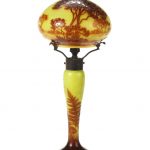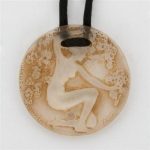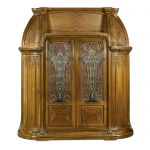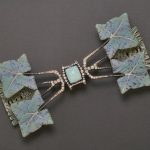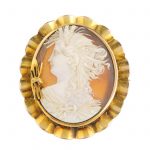Information on Art Nouveau design including a gallery and price guide of Art Nouveau cameos and cameo glass. From the 1880s until the First World War, western Europe and the United States witnessed the development of Art Nouveau (“New Art”). Taking inspiration from the unruly aspects of the natural world, Art Nouveau influenced art and architecture especially in the applied arts, graphic work, and illustration. Sinuous lines and “whiplash” curves were derived, in part, from botanical studies and illustrations of deep-sea organisms such as those by German biologist Ernst Heinrich Haeckel (1834–1919) in Kunstformen der Natur (Art Forms in Nature, 1899). Other publications, including Floriated Ornament (1849) by Gothic Revivalist Augustus Welby Northmore Pugin (1812–1852) and The Grammar of Ornament (1856) by British architect and theorist Owen Jones (1809–1874), advocated nature as the primary source of inspiration for a generation of artists seeking to break away from past styles. The unfolding of Art Nouveau’s flowing line may be understood as a metaphor for the freedom and release sought by its practitioners and admirers from the weight of artistic tradition and critical expectations.
Additionally, the new style was an outgrowth of two nineteenth-century English developments for which design reform (a reaction to prevailing art education, industrialized mass production, and the debasement of historic styles) was a leitmotif—the Arts and Crafts movement and the Aesthetic movement. The former emphasized a return to handcraftsmanship and traditional techniques. The latter promoted a similar credo of “art for art’s sake” that provided the foundation for non-narrative paintings, for instance, Whistler‘s Nocturnes. It further drew upon elements of Japanese art (“japonisme“), which flooded Western markets, mainly in the form of prints, after trading rights were established with Japan in the 1860s. Indeed, the gamut of late nineteenth-century artistic trends prior to World War I, including those in painting and the early designs of the Wiener Werkstätte, may be defined loosely under the rubric of Art Nouveau. Reference: The Metropolitan Museum of Art
An Art Nouveau Delatte Cameo Glass Lamp Signed in cameo ‘Delatte Nancy’; circa 1910 Acid-etched cameo decoration in reddish brown against a vibrant yellow ground, the shade depicting trees around a lake, the stand depicting the forest floor with ferns and fungi; with wrought iron mounts for the shade, height 43cm
Sold for £ 750 inc. premium at Bonhams in 2018
Art Nouveau Brown Crystal Cameo Pendant with Cord, Lalique Signed R. Lalique, Fioret Paris.
Sold for $437 (includes buyer’s premium) at Doyle New York in 2009
Art nouveau Beautiful 14k yellow gold hand carved cameo of a lady bust in red stone with a single cut white stone accent. Ring is marked with an H in a circle. Acid tested 14k gold. Ring is size 5. Victorian.
Sold for $150 at Appraisal & Estate Sale Specialists, Inc. in 2018
Louis Majorelle ‘AUX ALGUES’: A CABINET walnut, cameo and stained glass, wrought-iron mounts, carved with seaweed, the upper open shelves above a pair of glazed doors enclosing three adjustable shelves, flanked by a curved cupboard door enclosing two shelves wrought iron mount to each door signed ‘L. Majorelle / Nancy’ 231cm. high by 212cm. wide by 49cm. deep; 7ft 7in., 6ft 11½in., 1ft 7¼in. circa 1906
Sold for 25,000 GBP at Sotheby’s in 2010
This magnificent brooch is an outstanding example of Lalique’s jewelry. Here, layered fern leaves, in opalescent cameo glass and green enamel, are connected by diamond-set “stalks.” At the center a large cushion-shaped opal is mounted in a silver-gilt frame set with small diamonds of varying size. The lateral segments are hinged to the central unit to permit movement. Henry Walters bought this piece from Lalique in 1904 at the World’s Fair in St. Louis, Missouri. The symmetrical design anticipates Lalique’s future work. Within several years, the artist abandoned both jewelry and the Art Nouveau style to devote himself to the production of glass molded in the Art Deco style.
Reference: The Walter Art Museum
